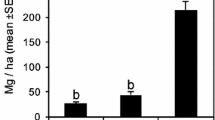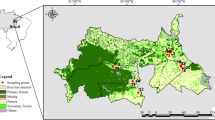Abstract
Forest succession following fire in a forest mosaic of northwestern Quebec has been studied in order to: (1) describe the successional pathways using communities of different ages and (2) evaluate convergence of successional pathways and possible effect of fire suppression on the establishment of steady-state communities. As a first step, ordination and classification techniques were used in order to remove changes in forest composition which are related to abiotic conditions. Then, ordinations based on tree diameter distributions were used to study shifts in species composition in relation to time since the last fire.
Even under similar abiotic conditions, successional pathways are numerous. However, regardless of forest composition after fire, most stands show convergence toward dominance of Thuja occidentalis and Picea mariana on xeric sites and dominance of Abies balsamea and Thuja occidentalis on more mesic sites. Stable communities of >300 yr occur on xeric sites while on mesic sites directional succession still occurs after 224 yr. Nearly all species involved in succession are present in the first 50 yr following fire. Only Abies balsamea and Thuja occidentalis increase significantly in frequency during succession. Following initial establishment, successional processes can generally be explained by species longevity and shade tolerance. Early successional species may be abundant in the canopy for more than 200 yr while the rapid decrease of Picea glauca, a late successional species could be related to spruce budworm outbreaks. Considering the short fire rotation observed (about 150 yr), a steady-state forest is unlikely to occur under natural conditions, though it may be possible if fire is controlled.
Similar content being viewed by others
References
Anon. 1982. Canadian climate normals. Canadian climate program. Environment Canada, Atmospheric Environment Service, Downsview, Ontario.
Ahlgren C. E. 1960. Some effects of fire on reproduction and growth of vegetation in northeastern Minnesota. Ecology 41: 431–445.
Arno, S. F. & Sneck, K. M. 1977. A method for determining fire history in coniferous forest of the Mountain West. USDA For. Serv. Gen. Tech. Rep. INT-42.
Bakuzis E. V. & Hansen H. S. 1965. Balsam fir: A monographic review. The University of Minnesota Press, Minneapolis.
Bergeron Y. & Bouchard A. 1984. Use of ecological groups in analysis and classification of plants communities in a section of western Quebec. Vegetatio 56: 45–63.
Bergeron Y., Camiré C., Bouchard A. & Gangloff P. 1982. Analyse et classification des sols pour une étude écologique intégrée d'un secteur de l'Abitibi, Québec, Géogr. Phys. Quat. 36: 291–305.
Bergeron Y. & Gagnon D. 1987. Age structure of red pine (Pinus resinosa Ait.) at its northern limit in Quebec. Can. J. For. Res. 17: 129–137.
Blais J. R. 1983. Trends in the frequency, extent, and severity of spruce budworm outbreaks in eastern Canada. Can. J. For. Res. 13: 539–547.
Brisson J., Bergeron Y. & Bouchard A. 1988. Les successions secondaires sur sites mésiques dans la MRC du Haut-Saintlaurent, Québec. Can. J. Bot. 66: 1192–1203.
Carleton T. J. & Maycock P. J. 1978. Dynamics of the boreal forest south of James Bay. Can. J. Bot. 56: 1157–1173.
Clayden S. & Bouchard A. 1983. Structure and dynamics of conifer-lichen stands on rock outcrops south of Lake Abitibi, Quebec. Can. J. Bot. 61: 850–871.
C.C.P. (Commission Canadienne de Pédologie). 1972. Classification Canadienne des sols. Min. Agr. Can. Ottawa.
Connell J. H. & Slatyer R. O. 1977. Mechanisms of succession in natural communities and their role in community stability and organization. Am. Nat. 111: 1119–1144.
Cottam G. & Curtis J. T. 1965. Use of distance measures in phytosociological sampling. Ecology 37: 451–460.
Dargie T. C. D. 1984. On the integrated interpretation of indirect site ordinations: a case study using semi-arid vegetation in southeastern Spain. Vegetatio 55: 37–55.
Diotte, M. & Bergeron, Y. 1989. Fire and the distribution of Juniperus communis L. in the boreal forest of Quebec, Canada. J. Biogeo. (in press).
Dix R. L. & Swan J. M. A. 1971. The roles of disturbance and succession in upland forest of Candle lake, Saskatchewan. Can. J. Bot. 49: 657–676.
Egler F. E. 1954. Vegetation science concepts I: Initial floristic composition, a factor in old field vegetation development. Vegetatio 4: 412–417.
Enright N. J. 1982. Recognition of successional pathways in forest communities using size-class ordination. Vegetatio 48: 133–140.
Foster D. R. 1985. Vegetation development following fire in Picea mariana (Black spruce)-Pleurozium forests of southeastern Labrador, Canada. J. Ecol. 73: 517–534.
Foster D. R. & King G. A. 1986. Vegetation pattern and diversity in S.E. Labrador, Canada: Betula papyrifera (Birch) forest development in relation to fire history and physiography. J. Ecol. 74: 465–483.
Foster J. R. & Reiners W. A. 1986. Size distribution and expension of canopy gaps in a southern Appalachian spruce-fire forest. Vegetatio 68: 109–114.
Fowells, H. A. 1965. Silvics of forest trees of the United States. USDA, Agric. Handb. No. 271.
Furyaev V. V., Wein R. W. & MacLean D. A. 1983. Fire influences in Abies-dominated forests. In: Wein R. W. & MacLean D. A. (eds), The role of fire in northern circumpolar ecosystems. Scope, 18: 221–234. Wiley, New-York.
GauchJr. H. G. 1982. Multivariate analysis in community ecology. Cambridge University Press, Cambridge, U.K.
Gauchjr. H. G. & Whittaker R. H. 1982. Hierarchical classification of community data. J. Ecol. 69: 537–557.
Heinselman M. L. 1973. Fire in the virgin forest of the Boundary Waters Canoe Area, Minnesota. Quat. Res. 3: 329–382.
Heinselman M. L. 1981. Fire and succession in the conifer forests of northern North America. In: West D. C., Shugart H. H. & Botkin D. B. (eds), Forest succession: concepts and application, pp. 374–406. Springer-Verlag, New-York.
Hill M. O. 1974. Reciprocal averaging: an eigenvector method of ordination. J. Ecol. 61: 237–249.
Hill M. O. 1979. TWINSPAN — A FORTRAN program for arranging multivariate data in an ordered two-way table by classification of individuals and attributes. Cornell University, Ithaca, N.Y.
Horn H. S. 1981. Some causes of variety in patterns of secondary successions. In: West D. C., Shugart J. H. & Botkin D. B. (eds), Forest succession: concepts and application, pp. 24–35. Springer-Verlag, New-York.
Hytteborn H., Packham J. R. & Verwijst T. 1987. The population dynamics, stand structure and species composition in the montane virgin forest of Vallibäcken, northern Sweden. Vegetatio 72: 3–19.
Johnson E. A. 1979. Fire recurrence in the subarctic and its implications for vegetation composition. Can. J. Bot. 57: 1374–1379.
Legendre L. & Legendre P. 1983. Partitioning ordered variables into discrete states for discriminant analysis of ecological classifications. Can. J. Zool. 61: 1002–1010.
McCune B. & Allen T. F. H. 1985. Forest dynamics in the Bitter-roots canyons, Montana. Can. J. Bot. 63: 377–383.
Noble I. R. & Slatyer R. O. 1980. The use of vital attributes to predict successional changes in plant communities subject to recurrent disturbances. Vegetatio 43: 5–21.
Rowe J. S. 1961. Critique of vegetational concepts as applied to forests of northwestern Alberta. Can. J. Bot. 39: 1007–1015.
Rowe J. S. 1972. Forest regions of Canada. Environment Canada, Ottawa.
Rowe J. S. 1983. Concepts of fire effects on plant individuals and species. In: Wein R. W. & MacLean D. A. (eds), The role of fire in northern circumpolar ecosystems. Scope 18: 135–154. Wiley, New-York.
Rowe J. S. & Scotter G. W. 1973. Fire in the boreal forest. Quat. Res. 3: 444–464.
Scott M. L. & Murphy P. G. 1987. Regeneration patterns of northern white cedar, an old growth forest dominant. Am. Midl. Nat. 117: 10–16.
Shafi M. I. & Yarranton G. A. 1973. Vegetational heterogeneity during a secondary postfire succession. Can. J. Bot. 51: 73–90.
Sokal R. R. & Rohlf F. J. 1981. Biometry, 2nd ed. Ronald Press, New-York.
Tamm C. O. 1964. Growth of Hylocomium splenders in relation to tree canopy. Bryologist 67: 423–426.
Taylor S. I., Carleton T. J. & Adams S. J. 1987. Understory vegetation change in a Picea mariana chronosequence. Vegetatio 73: 63–72.
Van Wagner C. E. 1983. Fire behaviour in northern conifer forest and shrublands. In: Wein R. W. & MacLean D. A. (eds), The role of fire in northern circumpolar ecosystems. Scope 18: 65–80. Wiley, New-York.
Van Wagner, C. E. 1971. Fire and red pine. Proc. 10th Ann. Tall Timbers Fire Ecol. Conf. pp. 221–224.
Viereck L. A. 1983. The effects of fire in black spruce ecosystems of Alaska and northern Canada. In: Wein R. W. & MacLean D. A. (eds), The role of succession in northern circumpolar ecosystems. Scope 18: 202–220. Wiley, New-York.
Vincent G., Bergeron Y. & Meilleur A. 1986. Plant community pattern analysis: a cartographic approach applied in the Lac des Deux-Montagnes area (Quebec). Can. J. Bot. 64: 326–335.
Vincent J. S. & Hardy L. 1977. L'évolution et l'extinction des lacs glaciaires Barlow et Ojibway et territoire québécois. Géogr. Phy. Quat. 31: 357–372.
Wein R. W. & MacLean D. A. 1983. Fire in northern circumpolar ecosystems. Scope 18. Wiley, New-York.
Author information
Authors and Affiliations
Rights and permissions
About this article
Cite this article
Bergeron, Y., Dubue, M. Succession in the southern part of the Canadian boreal forest. Vegetatio 79, 51–63 (1988). https://doi.org/10.1007/BF00044848
Accepted:
Issue Date:
DOI: https://doi.org/10.1007/BF00044848




